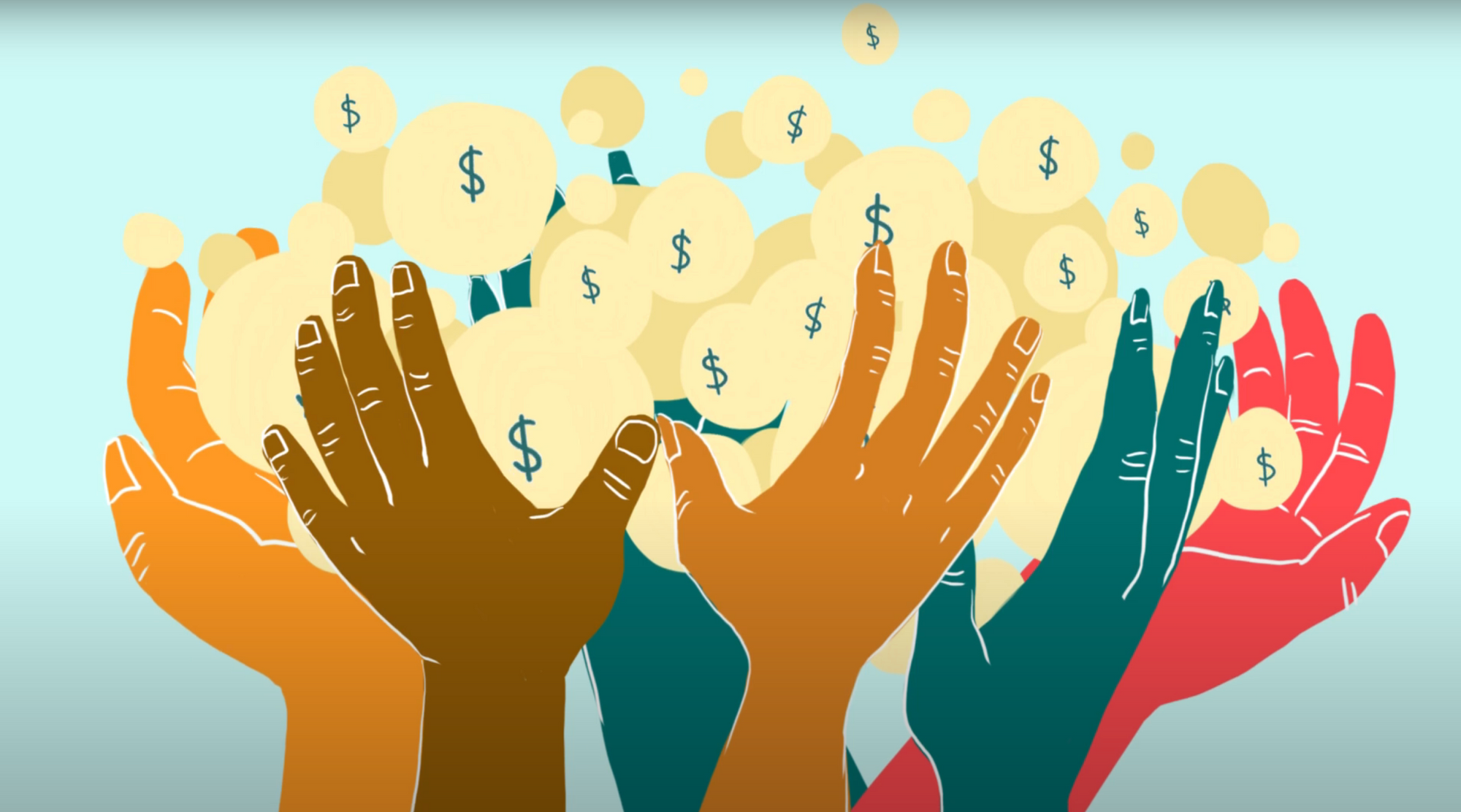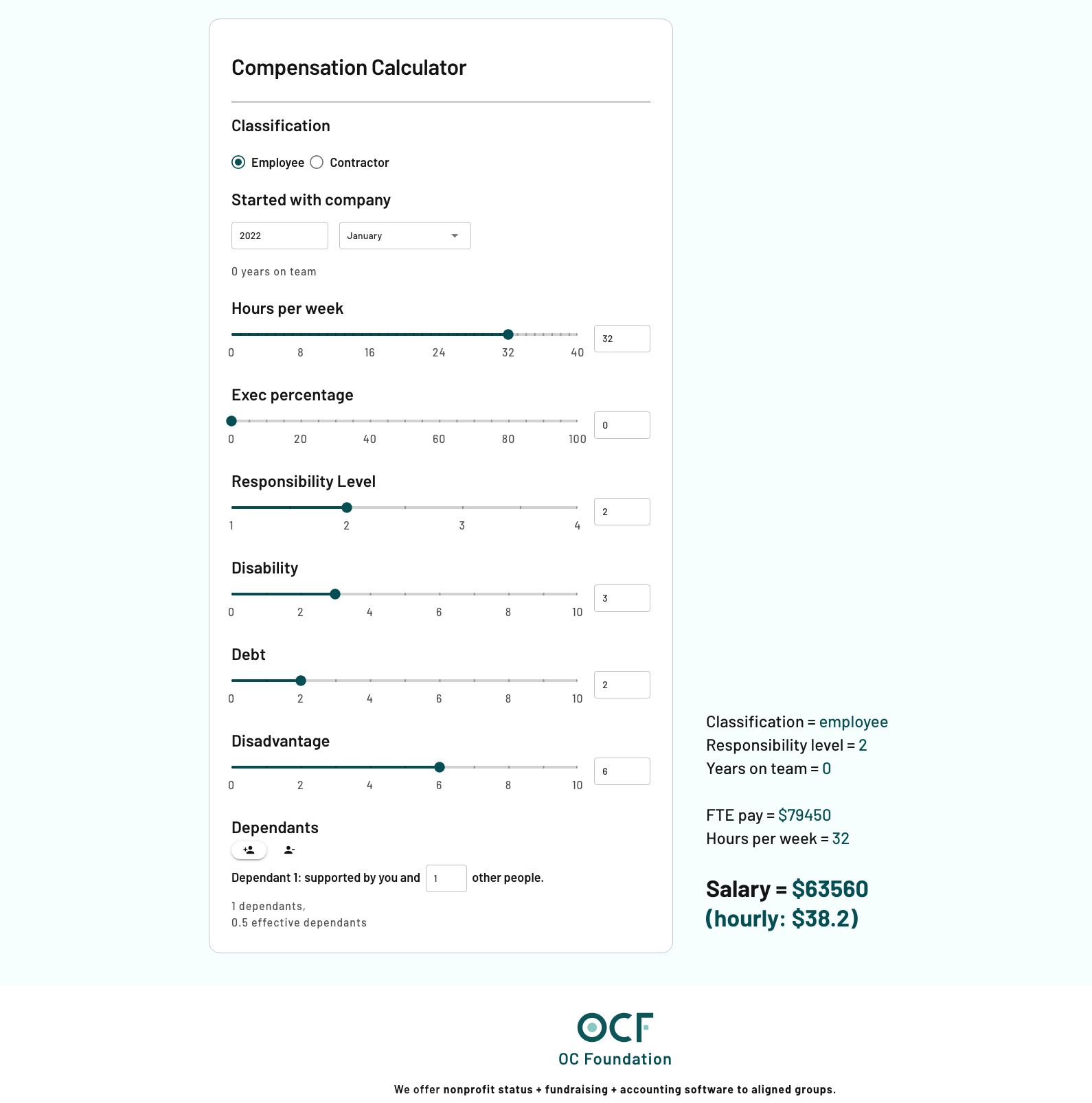How the team sets its own salaries at OCF (part 1)

Distributed leadership aligns with our guiding principle of solidarity at Open Collective Foundation, and it’s an area we’ve been intentionally developing. In mid-2022, we started rethinking how we pay our core team. We asked ourselves: how might our salaries be determined equitably and collectively?
Inspired by Worker Self-Directed Non-Profits and the work that Sustainable Economies Law Center and others have done around worker-set equitable pay, we engaged the help of Greaterthan, who has supported many organizations to create collaborative, participatory compensation models. After several months of work, we’re ready to announce the results of our first iteration.
This is part one, detailing the model we came up with and transparently sharing our staff's pay—part two is about the process we used and resources for other groups who might want to try something similar.
OCF’s new compensation model
Our compensation model combines elements of a formula (calculator), self-set factors (determined solely by the individual), and collectively set factors (determined in dialog with the team). It attempts to live up to the values of OCF and to meet organizational needs (fit our budget, attract and retain the staff we need). We’ve strived to balance privacy with transparency, as well as trust with accountability.
- Formula: The OCF compensation calculator gives a baseline starting point and embodies some key decisions about how we’ve decided pay should work in its design (see below for a breakdown).
- Self-set: Certain personal factors that adjust pay are set solely by the individual, and are not shared with or debated by the team. We trust each individual to set these variables on their own, using a rubric that we continue to develop together.
- Collective: The overall process and the formula have been agreed collectively by the team, and are overseen and continuously improved by a working group of team members. Individual compensation processes involve a review in a small group, and a point where anyone on the team can give input.
Our Compensation Formula
Try out the OCF compensation calculator for yourself! Move the sliders around to see how different factors impact the final numbers. Read more below about the variables, and how we define different factors in it.

Responsibility level
The most important factor in determining someone’s pay: how much responsibility and accountability someone holds for the organization as a whole. Levels 1-4 determine base pay from $60,000 to $90,000 per year. We started with the very basic descriptions below, and are creating a more detailed rubric that we’ll share soon.
- Level 1 ($60,000): Focuses on their own job, not expected be responsible for the team or organization more broadly, needs support/oversight/training from others.
- Level 2 ($70,000): Delivers some projects independently, growing into more responsibility, needs some support/training from others and also gives some support/training to others, is aware of our larger strategy.
- Level 3 ($80,000): Handles complex decisions and projects independently, fully understands our systems/policies, actively gives more support/training to others than they receive, gives input into and helps further our larger strategy.
- Level 4 ($90,000): Leads a team or work area, expert with specialized skills/knowledge, shares significant responsibility/expectation to set and deliver our mission/strategy overall.
Classification
Whether someone is an employee or a contractor. Contractors do not get benefits and have to handle their own taxes, etc, so contractor pay rates are a bit higher.
Tenure
We give a bump of 3% per full year served on the team, to recognize experience and loyalty.
FTE
'Full Time Equivalent' refers to how many hours per week someone works. This is a simple multiplying factor (you earn half the amount for half the hours).
Exec %
Exec as in Executive Director (ED). Additional pay reflecting the added responsibility level of this role. While only one person is ED now, we intentionally split this out in the model so that in the future it could be shared among multiple people if we move to a distributed ED function (next up in the distributing leadership plan).
Personal factors
This confidential section is for workers to self-determine how much they are affected by disability, debt, and disadvantage, and how many dependents they support financially. The answers to these questions are kept private, do not influence hiring or promotion decisions, and can only adjust someone’s pay upward. This recognizes the very real impacts these factors have on earning potential and financial needs. OCF values creating a more equitable society, and wants to reflect that in our compensation formula.
Compensation working group
The compensation working group is an opt-in ongoing role held by 3 people on the team. The working group is responsible for the compensation process as a whole, facilitating iterations and changes to the model, participating in individual compensation conversations, and being a resource for questions and feedback. Working group membership will rotate over time, but we intend turnover to be slow, to bring some experience and consistency to our compensation process as a whole.
Setting Compensation
Steps to determine someone’s pay:
- The worker uses the OCF compensation calculator to find a starting point number.
- A small group discussion with the worker, their choice of compensation working group member, and the worker’s steward (another peer on the team who has a role to support that person), to go over calculator results (without disclosing the private personal factors) and make any adjustments.
- The proposed compensation is shared with the rest of the team, at which point anyone may give feedback or raise concerns if needed.
- Compensation is confirmed.
Reviews and Adjustments
- Each person’s compensation will be reviewed at least annually, but it may happen more frequently if their role significantly changes, or at their request.
- Reviews follow the same process as setting initial compensation (use the calculator, have a small group meeting, announce to the team).
- Minor and straightforward adjustments might not require a full review (e.g. a simple change in number of hours per week).
- In addition to and separate from the 3% annual loyalty bonus that’s part of the calculator, OCF will make inflation adjustments annually, in line with actual inflation numbers. The same inflation adjustment will apply to everyone.
Why did we set it up this way?
Some of the thinking that went into our decisions about the model…
- Responsibility levels are designed to draw a map for people seeking to grow their roles, indicate that those with higher pay also consent to higher accountability, and give us a framework to think about performance and professional development.
- The lowest pay band is 150% of the living wage for high CoL states.
- The difference between the highest and lowest pay is 1.5x base, 1.75x with the ED pay included, and with other factors maxes out around 2x—a fair differential without huge inequality.
- It balances paying people based on value provided to the organization, skills and seniority level, supporting people with higher financial needs, and addressing social equity to an extent.
- Flexibility: people can tune their hours and responsibility level to what will help them best thrive in their role (this is why age or skill level are not explicitly in the formula, so a young person can be in a high responsibility role or vice versa, depending on ability and desires).
- We did not base the formula on ‘market rates’ because we prioritize contribution to and accountability to our mission, over how the capitalist economy might otherwise value someone’s labor.
“I’m excited about the model we supported the OCF team to design. It can be a great inspiration for other teams looking into alternative compensation practices. It combines the advantages of various models: using a formula to create a transparent salary foundation, self-set elements to provide contextuality and autonomy, and a final collective “thumbs up” to ensure any blindspots or tensions are addressed.”
—Francesca Pick, Greaterthan
OCF staff pay
Transparency is a huge part of what OCF is about. While you could always figure out how much we pay staff by looking at our transparent budget, it isn’t always straightforward. So we’re laying it all out here clearly.
(Learn more about these team members)
In aggregate, these changes resulted in a 14% increase in payroll costs, with raises for the majority of staff, especially lifting the floor on the lower end of the pay scale. This makes sense in light of rapid growth OCF has undergone in the last couple years and the results the team has delivered. Overall, our payscale seems to more or less align with other similar nonprofits we have researched.
Reflections from Team Members
“This was a true experiment, where pay rates weren’t predetermined, so I did feel a bit nervous going in. What would happen if our model resulted in doubling payroll costs, or going way out of line with other similar nonprofits? In the end, I’m really happy where we ended up: a model unique to us, that’s genuinely based on our values, a decent overall bump to what we’re paying staff (recognizing the huge growth of the organization and our team’s strong performance), but not wildly outside the norm. I’m proud to be transparent with our community about money, as it’s core to what we’re all about.”
—Alanna Irving
“I believe that the mixture of responsibility level and personal factors is a smart one. I am someone with high responsibility at OCF, and I am a queer parent with a dependent. I am also a white, able-bodied, cis-woman with class privilege. For this reason, I now make a bit less than I used to. It took me a while to come to terms with this. In future iterations, we need to make more room for hard conversations around money, rank, value, and self-worth. Many of us have not had reliable jobs or income before, and have been told that our work is not valuable, so this experiment of self-setting brings it all up. We need more containers in and out of the workplace to hold ourselves with care as we refine the process. I would only recommend this process to groups that include a lot of time and funds for personal and collective transformation around self-love, money, and work.”
—Caroline Woolard
“This compensation model offers a valuable internal experiment that we can run and learn from. It continues to surface some things that I experienced in the workshops about my relationship to money. I've expressed a desire to reduce my average hours without a noticeable reduction in responsibility, but the calculator created a moment of pause for how we internally value that. I want us to learn from that moment of pause.”
—Mike Strode
“Putting a number on how much your work is worth can be difficult, and for me it brought up a lot of internal battles around what I thought I deserved. Having support from the team throughout the process made it a lot less scary and more tangible and grounded. As a Black, Queer, non-binary, chronically ill person, who is a caregiver and expecting parent, I had never considered many of the questions raised in the calculator and discussions in my work. I realized that this process called for me to show up as my whole self, without apology, and to lean into trust. It called me to show up as my bold, abundant, and curious self, to ask questions and raise concerns when I needed to. Being part of a team that welcomes experimentation, research, and curiosity is truly heart opening, and I am so excited to see what’s next.”
—Sadé Swift
“Every member of our team has a high degree of autonomy, and I think our compensation system now recognizes the special value each of us brings. Each of us brought a lot of baggage to this process, but also a unique perspective and set of skills. I’m proud to be on a team that can take on complex challenges like this, and will continue to refine the process as we grow and change.”
—Nathan Hewitt
What’s Next?
We’ve reached a milestone, but we’re far from done. We learned a lot through the process of developing the compensation model—testing and reaffirming our core values and trust within our team, highlighting adjacent areas that we still need to work on, and thinking about how we might iterate the compensation model further.
Compensation model iterations
- A detailed rubric to help determine their responsibility levels, and to provide more guidance on the self-set factors (debt, disability, disadvantage).
- Reconsidering deficit framing, e.g. ‘disadvantage’ instead of positive recognition of the valuable perspectives and experiences people bring from diverse backgrounds and overcoming challenges.
- We may want more group input into setting the responsibility level of a given role before the individual dives into the calculator.
- Asking whether we should factor in differences like childcare costs and social safety net depending on where a staff member lives.
Adjacent areas of work
- Coaching, counseling, and support for staff, as they navigate the complex emotions around self-worth and money under capitalism.
- Performance evaluation and career development support, i.e. how can someone grow professionally with us, and what happens if they aren’t?
- Progressing our aspiration to distribute the Executive Director role (and its pay) beyond a single individual.
- Maturing how the compensation model syncs with overall budget planning.
Our initial three month trial is up at the end of February. This whole model is experimental, and we fully expect it will evolve, so we'll keep transparently sharing what we learn.
Are you interested in the process we followed to come up with this compensation model, or are you thinking about doing something similar in your own Collective or organization? Check out part two for the specific steps of the process we followed, and some helpful resources.

